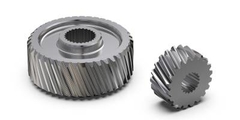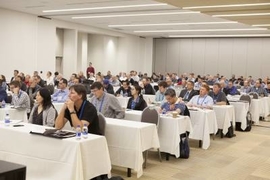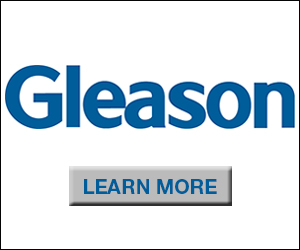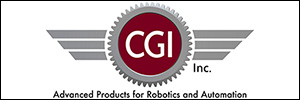 |
||||||||||||||||
AGMA Updates
The AGMA National Training Center, in partnership with Richard J. Daley College, provides industry-focused training for gear manufacturing employees. The NTC will host classes year-round for all levels, from basic gearing to operators, to advanced courses for engineers. The Center will also be used for networking events, AGMA committee meetings, and more. Learn more and R.S.V.P. today!
Aug. 3 – Manufacturing and remanufacturing of metal parts using laser-blown powder | DM3D
Sept. 7 – AGMA Emerging Technology Efforts – What’s Next? | AGMA Oct. 5 – Robot Simulation: Make the Most of your Investment in Automated Manufacturing | Weldon Solutions
Learn how to develop and understand customer gear drive application specifications and target performance expectations. Review, calculate and select basic gear terminology variables and design parameters which define tooth bending and contact rating safety factors on two real life examples. Learn how to fit new gear designs and ratios into existing center distance. Use commercially available software to calculate and optimize gear set power density. Discuss time and cost of more than 20 other gear drive component functions and drive development steps through prototypes to shipment of compliant assembled production drives. There will be an opportunity to discuss gear design challenges which may be unique to participant industries.
Learn the fundamentals of gear manufacturing in this hands-on course. Gain an understanding of gearing and nomenclature, principles of inspection, gear manufacturing methods, and hobbing and shaping. Utilizing manual machines, develop a deeper breadth of perspective and understanding of the process and physics of making a gear as well as the ability to apply this knowledge in working with CNC equipment commonly in use.
Technology is fundamentally changing manufacturing. To keep up in today’s marketplace, designers and manufacturers need to follow the emerging trends and communicate the latest ideas with their fellow experts in the field. AGMA’s annual Fall Technical Meeting (FTM) is the perfect forum for this. Each year, 30 authors are selected by AGMA to write peer-reviewed technical papers on topics relevant to the gear industry. Topics include: design, analysis, manufacturing, quality, materials, metallurgy, heat treatment, operation, maintenance, efficiency, and gear failure. Authors present the results of their papers in a single-track conference, which means you don’t have to pick and choose which presentations to attend. With a full registration you receive copies of all papers, are able to see all the presentations, ask questions to all the presenters, and network with your peers over three days.
Industry News
Institute for Supply Management
Economic activity in the manufacturing sector grew in June, with the overall economy achieving a 25th consecutive month of growth, say the nation’s supply executives in the latest Manufacturing ISM Report on Business. Automotive Powertrain Technology International
Ducati has released technical details of its MotoE project, with Claudio Domenicali, the company’s CEO, commenting, “A few weeks ago I had the extraordinary opportunity to ride the Ducati MotoE on the track and I immediately realized that I was living in a historic moment. The world is going through a complex period and environmental sustainability is an element that all individuals and all companies must consider a priority if we want to preserve the delicate balance of the planet. Automotive Powertrain Technology International
Daimler Truck says it has reached the next milestone in the development of its hydrogen-fueled trucks. For the past year, a Mercedes-Benz GenH2 Truck fuel-cell prototype has been undergoing intensive testing – both at the company’s in-house test track and on public roads. Daimler is now putting another prototype into operation to test the use of liquid hydrogen.
CBIA
The manufacturing industry was the most attacked industry in 2021, surpassing financial services, according to billions of data points analyzed by IBM. Ransomware, the top attack type, accounted for nearly a quarter of the attacks on manufacturing companies. Today’s e-Mobility
Volvo Autonomous Solutions (VAS), a Volvo Group company, will offer a new hub-to-hub autonomous transport solution, designed to serve four main customer segments: shippers; carriers; logistics service providers; and freight brokers. Each solution will be configured to suit the business needs of the specific segments while addressing the growing demand for goods movement in North America. Today’s e-Mobility
BorgWarner, a developer of innovative and sustainable mobility solutions for the vehicle market, received a $4.09 million U.S. Department of Energy (DOE) Award to design and develop a cost-effective, advanced direct current fast charger (DCFC). BorgWarner received one of 25 research, development and demonstration projects which aim to advance electrification, reduce vehicle emissions, and improve EV charging infrastructure.
Gear Technology
Gear manufacturing involves a number of processes that, intentional or not, affect the residual stress state of the critical surfaces. Stresses, including residual stresses from processing, are commutative, with compressive stresses typically improving fatigue life and crack initiation while tensile stresses do the opposite. Accordingly, gear designers and manufacturers often require compressive residual stresses at the surface on critical geometries such as gear teeth and roots. Gear Technology
The fascination of the automotive differential has led to the idea to build a second differential unit around a first center unit. Both units have the same axes around which they rotate with different speeds. The potential of double differentials as ultrahigh reduction speed reducers is significant. Only the tooth-count of the gears in the outer differential unit must be changed in order to achieve ratios between 5 and 80 without a noticeable change of the transmission size.
Freemelt patents ‘freezing’ technology for finishing 3D printed parts with complex internal channels
3D Printing Industry
Swedish 3D printer manufacturer Freemelt has been granted patents for a novel approach to post-processing that allows excess powder to be ‘frozen’ out of complex parts. Designed for finishing powder bed fusion printed parts, the process involves filling them with saline water, which is then frozen in a way that breaks the links between powder grains stuck in their internal channels, making any excess easier to eject. Modern Machine Shop
This aerospace and defense supplier has a strategy to take advantage of the flexibility in its newest and largest five-axis gantry-type machining center.
Fortune
Tesla will mothball production for two weeks at its new factory in Germany only a few months after assembly lines roared to life.
McKinsey & Company
Manufacturers in industries such as automotive and electronics, nearing the tipping point of digital adoption, are achieving even faster and more sustainable change through Industry 4.0. Automation.com
With the maturation of renewable-energy harvesting technologies, green energy is gradually becoming a viable alternative to conventional, environment-unfriendly power sources. For all its benefits, this new reliance on green energy puts stress on grid stability. Since grids rely heavily on balancing power supply and demand, the unpredictability of green energy brings about several challenges. Technology that allows a grid to respond quickly to power fluctuations is crucial to ensure a more resilient grid. This is where the Virtual Power Plant (VPP) enters the picture.
Assembly Magazine
Automotive OEMs love to show off their automated body-in-white assembly lines. Commercials invariably feature dozens of six-axis robots producing showers of sparks in choreographed routines. The footage portrays the OEM as a technological leader, even if every auto plant in the world has such a line. Power Transmission Engineering
Servo motors are used in numerous markets to power machines, instruments, robots, and other factory automation applications. The Kollmorgen blog addresses five major elements of a conventional brushless DC servo motor: the rotor, stator, bearings, feedback and housing. |
||||||||||||||||
| Past Issues | Subscribe | agma.org | ADVERTISE WITH US | ||||||||||||||||











